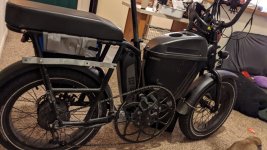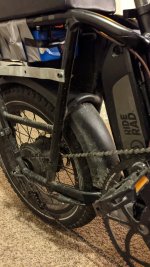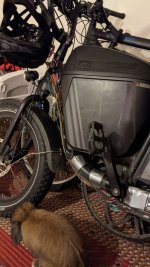itsraspberrytime
1 µW
- Joined
- Mar 18, 2021
- Messages
- 2
Hi guys. I'm new to endless sphere but hear it's a must for anyone DIY'ing ebikes. And I mean just look at the pics. I am pretty deep in this project. So his name is Ghost. He started as a regular off-the-shelf RadRunner from the online store at rad power bikes. Since I got him a year ago, I've done successive modifications on him until he is now
![url]](/sphere/proxy.php?image=http%3A%2F%2F%5Bimg%5D%5Burl%5D%5B%2Furl%5D&hash=e739958e821ed6ab2bdccd0c63a67efc) [/img] unrecognizable. Like the age old saying goes, if you replace every part of a ship over time, is it still the same ship?
[/img] unrecognizable. Like the age old saying goes, if you replace every part of a ship over time, is it still the same ship?
In this case, kinda but not really. I've overhauled every piece of circuitry on this thing except the motor, because I wanted him to go faster. Waaaay faster. Crunched the numbers and figured out, 20? Nah I know we can go 50. Check out that 100 tooth crank gear. Came from Australia. Every piece of this infuriating puzzle has tried its hardest to keep from being put together:
-new motor didn't fit
-rear wheel not wide enough for a freewheel/cassette so no shifting
-printed and soldered a faux phase generator to disable the 20 mph speed limiter that (surprise!) didn't work
-rewired a new battery which fried the old display somehow, still not sure about that one
As well as a plethora of other problems I can't even remember. He's been operational about as long as he's been upside down scattered across the workshop.
So, that frickin speed limiter that I've been trying to rip out since the moment he first arrived?
Ordered a new controller, throttle, display and replaced all the old electronics. It took two months, the second one being more banging my head against the wall and staring at his sad corpse defeated more than anything-
BUT HES FINALLY UP AND RUNNING AGAIN!!!!!!!!
Finally today I felt like I was on top of the world again. Something to be broken that you've put so much love into is disheartening. But he's finally back. And no surprise, but he's gotten himself into trouble. AGAIN. ALREADY.
I'm about done. You know that feeling? I thought after alllll this time as soon as I had that new controller on, now he's gonna be everything I dreamed. I thought I would be keeping up with traffic, no longer looking behind me and swerving and that I would have hands down THE FASTEST means of transportation in the city. So here's what's happening. He is an untamable beast on startup. If I crank the throttle at a standstill he does a wheelie. Made me fall over a couple times. But as soon as he gets to 20 he slows to a crawl. And I have no idea why.
But as soon as he gets to 20 he slows to a crawl. And I have no idea why. As soon as I hit 22.5 he goes from 600 watts (he's a 500 watt with 750 peak motor) down to 400, and the more I pedal, 300, 200, 150. WHY?????? It's driving me crazy. Noticing no matter how much I pedal I can't get him above 23 for any length of time. When I thought he was finally gonna feel his potential, running at full power all the time......
As soon as I hit 22.5 he goes from 600 watts (he's a 500 watt with 750 peak motor) down to 400, and the more I pedal, 300, 200, 150. WHY?????? It's driving me crazy. Noticing no matter how much I pedal I can't get him above 23 for any length of time. When I thought he was finally gonna feel his potential, running at full power all the time......
My setup is a KT-LCD3 display. Yes I changed the max speed to 99 km/hr.
KT 500/750/1000/1500 watt controller
Push throttle
Idk my PAS stats but it's the standard 3 wires
Bafang brushless 5:1 geared hub motor 500 watt from rad power bikes
Is there something fundamentally flawed in my understanding of ebike wiring? Is there a perfectly good reason the motor wattage slows to a halt? Thinking maybe it's unable to spin any faster than that but questionable and if so
questionable and if so . Seems a weird point to flatline. Something I can change in the display? Do I need to become a hacker. Aware of the P and C options stated in the manual but haven't touched them. I don't know my motor THAT well.
. Seems a weird point to flatline. Something I can change in the display? Do I need to become a hacker. Aware of the P and C options stated in the manual but haven't touched them. I don't know my motor THAT well.
I know this is a long post. I'm excited. He's been a lotta fun but I find myself at a standstill. ANY thoughts are welcome. I have an old manager, disappointed grandfather, jealous brother, and ex all to prove wrong....
In this case, kinda but not really. I've overhauled every piece of circuitry on this thing except the motor, because I wanted him to go faster. Waaaay faster. Crunched the numbers and figured out, 20? Nah I know we can go 50. Check out that 100 tooth crank gear. Came from Australia. Every piece of this infuriating puzzle has tried its hardest to keep from being put together:
-new motor didn't fit
-rear wheel not wide enough for a freewheel/cassette so no shifting
-printed and soldered a faux phase generator to disable the 20 mph speed limiter that (surprise!) didn't work
-rewired a new battery which fried the old display somehow, still not sure about that one
As well as a plethora of other problems I can't even remember. He's been operational about as long as he's been upside down scattered across the workshop.
So, that frickin speed limiter that I've been trying to rip out since the moment he first arrived?
Ordered a new controller, throttle, display and replaced all the old electronics. It took two months, the second one being more banging my head against the wall and staring at his sad corpse defeated more than anything-
BUT HES FINALLY UP AND RUNNING AGAIN!!!!!!!!
Finally today I felt like I was on top of the world again. Something to be broken that you've put so much love into is disheartening. But he's finally back. And no surprise, but he's gotten himself into trouble. AGAIN. ALREADY.
I'm about done. You know that feeling? I thought after alllll this time as soon as I had that new controller on, now he's gonna be everything I dreamed. I thought I would be keeping up with traffic, no longer looking behind me and swerving and that I would have hands down THE FASTEST means of transportation in the city. So here's what's happening. He is an untamable beast on startup. If I crank the throttle at a standstill he does a wheelie. Made me fall over a couple times.
My setup is a KT-LCD3 display. Yes I changed the max speed to 99 km/hr.
KT 500/750/1000/1500 watt controller
Push throttle
Idk my PAS stats but it's the standard 3 wires
Bafang brushless 5:1 geared hub motor 500 watt from rad power bikes
Is there something fundamentally flawed in my understanding of ebike wiring? Is there a perfectly good reason the motor wattage slows to a halt? Thinking maybe it's unable to spin any faster than that but
I know this is a long post. I'm excited. He's been a lotta fun but I find myself at a standstill. ANY thoughts are welcome. I have an old manager, disappointed grandfather, jealous brother, and ex all to prove wrong....




